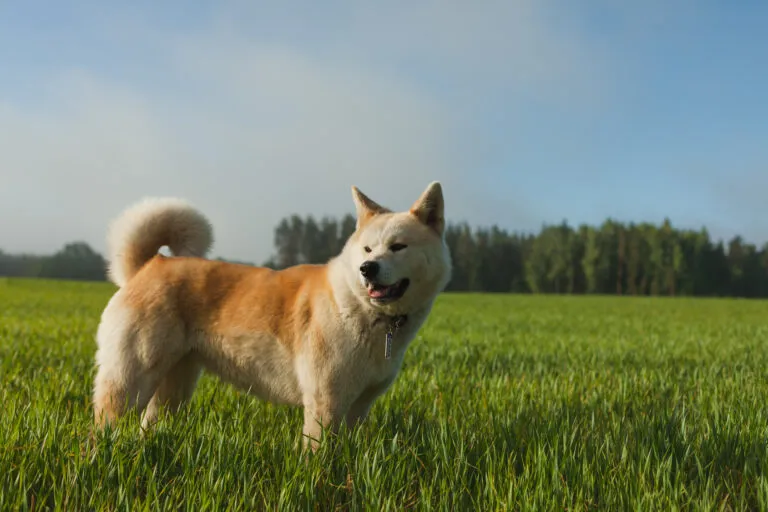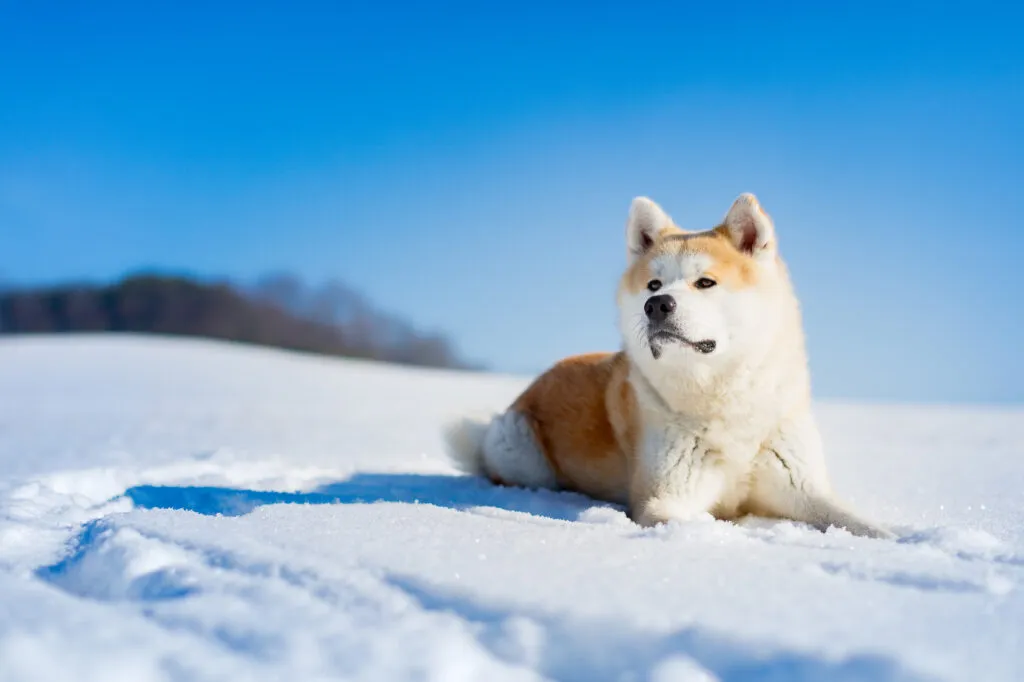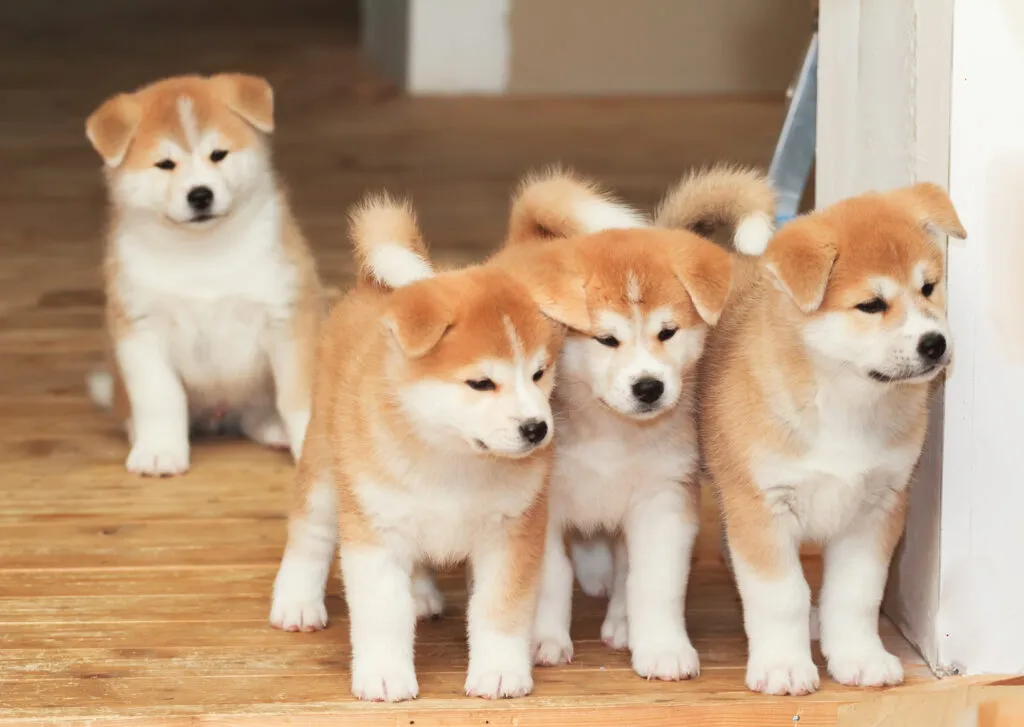Medium Size Poodle
The proud and beautiful Akita Inu, with its large, powerful stature, is considered a national treasure in its homeland of Japan. Originally bred as a hunting dog, today it is only somewhat suitable as a companion dog. Due to its independence, this breed should be in the hands of experienced dog owners.

© Zanete / stock.adobe.com
The beautiful, loyal, but also wilful Akita Inu is particularly suited for experienced dog lovers.
The Akita Inu belongs to the Spitz group, which is usually associated with smaller dogs. However, this Japanese breed is a striking exception, not least due to its size.
Standing up to 70cm tall at the shoulder, the Akita Inu is undoubtedly a large dog. It has a muscular and powerful body. Its broad forehead with a distinctive crease and its characteristic triangular, upright ears exude dignity and alertness. Another typical feature is the tightly curled rod that the Akita carries on its back.
The fur of this noble Japanese dog feels hard and coarse on the outside. However, it has a soft and dense undercoat that provides reliable protection from wind and weather. Traditionally, the coat is fawn or sesame (red-fawn hair with black tips). Additionally, brindle and white dogs are accepted.
According to the breed standard, all colours except solid white dogs must display “Urachiro.” This refers to whitish hair on the sides of the catch, cheeks, under the jaw, neck, stomach, rod and the inner sides of the limbs.
The Akita likes things to be quiet and manageable. This Japanese breed dog doesn’t appreciate visits to crowded dog parks or bustling family gatherings.
Though the Akita needs its family around, its owner is usually company enough. It is generally patient and loving towards the family’s children but doesn’t fare well with boisterous play from visiting children. To avoid unpleasant encounters, the Akita should not be left unsupervised with children or visitors.
It does not need contact with strangers or other animals but requires a strong family bond. Left alone, this independent dog will find its own ways and activities.
While it exudes dignified calmness indoors, it tends to hunt and run wild outdoors. It takes considerable skill, empathy, and know-how to manage this willful dog.
An Akita Inu may follow a person willingly, provided the person trains it with patience, love, and consistency. This dog forgives neither undue harshness nor injustice.
An owner who guides their four-legged friend from puppyhood, sets boundaries and tolerates its stubbornness will find a wonderful and incredibly loyal companion in an Akita. As such, it will always stand protectively by its family.
This loyalty made the Japanese Akita Inu Hachikō a legend. The dog, about whom a film was made in 2009 starring Richard Gere, accompanied its owner daily to Shibuya Station in Tokyo in the 1920s. There, it would always pick the owner up at the same time.
When the owner died, Hachikō waited at the station for almost ten years—until its own death—for the owner’s return. A statue and the “Hachikō Exit” at the western exit of Shibuya Station still commemorate the famous Akita.
Akitas absolutely need experienced owners who understand dogs and training well. They should also have plenty of time and be willing to seriously and intensely engage with this breed. Early and consistent training and comprehensive socialisation are essential for harmonious living with an Akita.
However, even with this training, you won’t make your dog delighted about meeting strange dogs. An Akita Inu remains a loner, with its family being company enough. Therefore, those dreaming of a dog that can go everywhere, is comfortable with noise, and enjoys frolicking in dog parks are likely poorly advised to get this breed.
But, those who appreciate the uniqueness, pride, and independence of this Japanese dog will find an incredibly loyal and steadfast partner in an Akita, one they won’t want to be without.
 © sestaeli / stock.adobe.com
© sestaeli / stock.adobe.com
To maintain health, proper grooming is essential. Generally, the hard and relatively short fur of Akitas requires minimal coat care. Thanks to an excellent self-cleaning mechanism, brushing your dog once a week and removing any debris after walks is usually sufficient.
However, during shedding periods (twice a year), you must brush daily and thoroughly to remove old, dead hair.
At first glance, the Akita may seem like a low-maintenance dog: It enjoys quiet, long walks and does not need new sporting and mental challenges daily like other breeds. However, its somewhat obstinate character requires the owner to have considerable knowledge, patience, and empathy.
Even the best dog trainer cannot get an Akita to perform what it sees as pointless commands. This serious and dignified breed has no interest in silly games or sport tricks.
Therefore, an Akita is rarely seen in dog sports. However, it is an excellent athlete that can achieve great results if it sees a purpose in the exercise. The success, whether in sports or training, depends heavily on the owner’s motivational skills. The owner must convince the Akita that obedience benefits it.
Despite careful breeding practices to maintain the health of Akita Inus, some representatives still struggle with hereditary diseases and other vulnerabilities. These include skin and hair conditions (e.g., sebadenitis), autoimmune disorders, progressive retinal atrophy, epilepsy, thyroid diseases and the commonly found hip dysplasia (HD) in large breeds.
Responsible breeders test breeding animals for typical breed diseases to reduce the risk of such conditions as much as possible.
The key to a long life for your dog is not just buying a healthy puppy but also ensuring it receives appropriate nutrition. When choosing food, quality should be the priority over price.
This doesn’t mean the most expensive food is always the best. Regardless of cost, examine the ingredients closely. Your dog’s food should be balanced, providing all essential nutrients in the correct proportions.
Discover our selection of dog food: In the zooplus online shop, you’ll surely find the right dry dog food or wet dog food for your beloved pet.
Akitas are known for being picky eaters. It may take a while to find food that is both healthy and appealing to your pet.
Avoid switching food too quickly. Allow your dog to adapt to the taste gradually and give its stomach time to digest the new food properly. Frequent food changes can stress the dog’s system and may lead to diarrhoea or constipation. Therefore, transition to a new diet gradually—a week is often a good period for complete adjustment.
Akita Inus are prone to skin problems like allergic rashes. Therefore, avoiding pork and high-soya food is advisable. Recommended meats include beef, lamb, game or ostrich. How you serve it is up to you and your dog’s preferences. Ensure adequate fluid intake when feeding dry food.
Avoid too many treats to keep your dog at its ideal weight. Two meals a day are sufficient. It’s best to weigh the daily portions to prevent overweight.
In its homeland Japan, the Akita Inu was known long before the famous Hachikō. Dog depictions on clay vessels or bronze bells trace the original dog type back nearly 5,000 years.
Genetic studies have shown that the Akita, along with Shiba Inus, Chow Chows, and Shar Peis, are the closest relatives to wolves. Thus, the breed is one of the oldest in Asia.
In 1931, the Japanese emperor declared the Akita Inu a national monument. Until 1945, exporting the breed from Japan was prohibited.
There are many theories about the exact ancestry of the Japanese national breed, but it’s certain that the first purebred dogs were discovered in the Akita region of Japan. From there, they spread across Japan and later to Europe and America.
After World War II, the Akita Inu population was significantly reduced. The remaining Akitas varied considerably in appearance and temperament.
This led to the creation of two breed lines: the Japanese Akita Inu described here and the “American Akitas,” which resulted from crossbreeding Akitas with shepherd dogs exported by the American military.
In Japan, breeders focused on restoring the original breed, crossing Akitas with Matagi Akitas. Today, both the more authentic, slightly smaller Japanese line and the larger, darker American line are recognised as separate breeds by the FCI.
Originally, the Akita Inu was used for hunting bears, wild boar, and birds. It also served as a guard dog and draft dog.
In the 19th century, the Akita participated in cruel but popular dog fights. To make fighting dogs larger and stronger, breeders introduced Tosa and Mastiffs. In 1908, these fights were banned in Japan.
Today, the loyal Akita Inu is primarily kept as a family and companion dog. Nonetheless, its protective instinct, strength and hunting drive are still apparent. Therefore, proper physical and mental stimulation and consistent training are necessary for keeping an Akita as a family dog.
 © nkarol / stock.adobe.com
© nkarol / stock.adobe.com
The Japanese recognised the significance of this proud dog early on. By the early 20th century, they promoted the targeted breeding of the national breed.
They rejected the different lines created through crossbreeding with German Shepherds, viewing them as a split rather than an enrichment of the breed.
Therefore, breeding efforts soon focused on the original breed. This type had a more slender build, a Spitz-like head and a shorter back compared to the American Akita. Crossbreeding with the Kishu Inu, Japanese sled dogs, Chow Chows, and especially Matagi Inus helped achieve this goal.
Maintaining the original, pure breed remains the focus of today’s breeders not only in Japan but also in many European countries. Collaborating closely with scientists and researchers, they strive to preserve the features of original Akitas while avoiding genetic defects or unwanted traits.
Achieving healthy and socially compatible breed dogs requires stringent breeding standards and a great deal of commitment from breeders. Serious breeders don’t accept overbred or disease-prone dogs, excluding them from breeding.
Anyone considering an Akita Inu as a new family member should only look for reputable breeders. Such breeders are members of Akita clubs or dog breeding associations, breeding according to the rules of the Fédération Cynologique Internationale (FCI).
Only then can you be sure that all breeding regulations are met, ensuring a healthy and reliable breed dog who will bring you years of delight. By avoiding “cute” puppies from commercial sellers and puppy mills, you do yourself and the entire Akita breed a favour.
You might also check shelters. Occasionally, purebred Akita Inus await a new home there. Or perhaps a mixed breed will steal your heart? The animal protection sector has many wonderful dogs looking for a loving family.
Fans of the Bearded Collie agree that those who aren't familiar with this dog breed simply have to get acquainted with it. And those who have experienced how a Bearded Collie bolts across meadows with its flowing fur, how it rolls around full of energy and joy and how it attentively and observantly takes into account its owners wishes become simply addicted to this original dog breed and its unique charm.
The Goldendoodle isn't a breed, but a pairing between Golden Retrievers and Medium or Standard Poodles. Marketed as a low-maintenance dog for allergy sufferers, this hybrid is enjoying increasing popularity amongst dog lovers, similar to the Labradoodle.